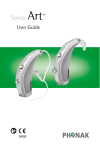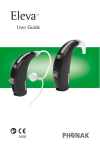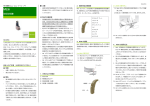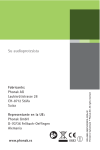Download User Manual Versáta BTE
Transcript
Versáta BTE User Guide 0459 0682 ! Contents Welcome 5 Description Versáta 6 Short introduction Inserting the battery Switching ON/OFF Controlling the volume Selecting a hearing program 8 8 9 9 Preparation Replacing the battery Tamper proof battery compartment Identifying left and right instruments Inserting Versáta hearing system with earmold into your ear Inserting Versáta hearing system with Fit’nGo slim tube into your ear Fine tuning your Versáta hearing system 2 10 13 15 16 20 24 Operation Switching ON/OFF Controlling the volume Hearing programs Synchronized manual control Telecoil (optional) EasyPhone (optional) 25 26 28 29 30 30 Wireless accessories (optional) myPilot iCom iView 34 36 38 Remote control (optional) 39 FM communication (optional) Multi-frequency FM transmitter Multi-frequency FM receivers Attaching and removing MicroLink FM receiver ML9i, ML9S and AS9 audio shoe MyLink (optional) EasyFM Manual selection of an FM program 41 42 43 44 46 47 47 3 Contents 48 51 55 Warning 58 Service and Warranty 59 Phonak distributors worldwide 62 4 Maintenance Wind and Weather Protector Fit’nGo slim tube Important points Welcome Your new Versáta hearing system uses the very latest advances in digital wireless hearing technology. Versáta offers you automatic functions providing the highest sound quality, speech understanding and listening comfort in most of your hearing situations. High-tech has turned highly sophisticated hearing systems into convenient devices that are easy to use. Please read this manual carefully to benefit from all the features of your new hearing system. Ask your hearing care professional if you have any questions. Versáta is a quality product developed by the Swiss company Phonak, a world leader in hearing technology, innovation and reliability. With proper care and usage, your hearing system will support your hearing and communication needs for many years. For further information, please visit the Phonak website www.phonak.com. Phonak – life is on 5 Description 햲 햶 햷 햳 햴 햵 Hearing system with earmold 햲 햳 햴 햵 햶 햷 6 Microphone inputs with Wind and Weather Protector Program switch Volume control Battery compartment with ON/OFF switch Hook/sound output Individual earmold 햲 햶 Hearing system 햳 with Fit’nGo slim tube and dome 햲 – 햵 see page 6 햶 Slim tube/ sound output 햷 Dome 햸 Retention 햷 햴 햸 햵 Hearing system with Fit’nGo slim tube and SlimTip 햳 햲 – 햵 see page 6 햶 Slim tube/ sound output 햷 Individual SlimTip 햸 Removal handle 햶 햲 햷 햴 햸 햵 7 Short introduction Inserting the battery Details see page 11 Switching ON/OFF Details see page 25 ON 8 OFF ON Controlling the volume Details see page 26 Volume up Volume down Selecting a hearing program Details see page 28 9 Preparation Replacing the battery Use battery size 13 for all Versáta Behind the Ear instruments. Using the nail grip, open the battery compartment completely and remove the old battery. Remove the protective foil from the new battery. 10 Insert the new battery with the “+” sign (flat side of the battery) in line with the “+” marked on the battery compartment and close it. 11 Preparation Handle the battery compartment with care and do not use excessive force. If there is any resistance when closing the compartment, ensure that the battery is inserted correctly. The compartment may not close properly if the battery is upside down, and the instrument will not work. When your hearing system is not in use, leave the battery compartment open to allow any moisture to evaporate. Low battery warning An acoustic signal gives you an early warning that the battery is approaching exhaustion. You have approximately 30 minutes to replace the battery after hearing the signal. This reserve may be higher and the hearing system will repeat the low battery warning approximately every 30 minutes. Please note that the battery consumption increases with regular use of the myPilot command center, the iCom communication interface or remote controls such as KeyPilot2 or WatchPilot2. 12 Tamper proof battery compartment To protect children from the dangers of playing with batteries, a special locking system may be mounted on the instruments. This locking system can also be used for identifying left and right instruments (see page 15). To lock the battery compartment, after it is closed: Use a small screwdriver and turn the screw to its middle position (slot vertical). To unlock the battery compartment: Turn the screw to its horizontal position. 13 Preparation Please make sure that the screw is in the unlocked position when you close the battery compartment. Locked Unlocked The ON/OFF switch is not available when the battery compartment is locked. To switch the hearing system OFF, it is necessary to unlock the tamper proof battery compartment. 14 Identifying left and right instruments It is important to use the correct hearing system for each ear. Your hearing care professional can mark the hearing systems for you. The color code on the housing will identify left and right hearing systems. The color code is as follows: red = right blue = left 15 Preparation Inserting your hearing system with earmold into your ear Using the hand on the same side you wear your hearing system, grasp the earmold between the thumb and index finger. Raise your hand to your ear making sure the canal portion of the earmold faces your ear. Tilt your hand slightly forward. 16 Place the canal portion of the earmold inside your ear canal. If it is difficult to get it into place, stretch your ear by pulling it gently backwards and upwards with your other hand. When the canal portion is in place, twist the earmold backwards so that it fits into the concha and the helix portion is under the fold. 17 Preparation Now position the hearing system behind the ear. Be careful not to twist the tubing. 18 Check the placement of the earmold by tracing the contour of the ear with your finger. To remove your hearing system, grasp the earmold, not the tubing, and pull it out of your ear gently but firmly. 19 Preparation Inserting your hearing system with Fit’nGo slim tube into your ear Open domes and SlimTip 햲 Place the hearing instrument over the top of your ear 햲. 햳 Hold the slim tube where it attaches to the dome or SlimTip 햳 and gently push the dome or SlimTip into your ear canal. The dome or SlimTip should be placed far enough into the ear so that the slim tube lies flush with your head. 20 햴 Place the retention tail (if available) of the slim tube into the bowl of your concha 햴. To remove your hearing instrument, grasp the slim tube near the dome and pull it out of your ear gently but firmly. In very rare cases, the dome can remain in the ear canal when removing the slim tube from the ear. In the unlikely case that any parts remain in the ear canal, it is strongly recommended to see a medical specialist for safe removal. 21 Preparation Closed domes The closed dome has a different design than other domes (refer to picture). The closed dome consists of two fins overlapping each other. Before inserting the closed dome into the ear canal it is important to check the position of these fins. The larger fin must be positioned over the smaller fin, see picture 햵. If the position is incorrect 햶, you can easily adjust it. With one finger, gently bend the bigger fin forwards and then back again so that it overlaps the smaller one, see picture 햷. Make also sure that the slit of the closed dome is in a horizontal position on the tube unit, as shown in picture 햵. Your closed dome is now ready to be inserted into the ear. 22 Correct position 햵 Wrong position 햶 Moving the fins 햷 23 Preparation Fine tuning based on your personal preferences The fitting process has limited capabilities of reproducing the full spectrum of your personal sound environments. This limitation is overcome by the ability of Versáta hearing systems to learn from your real life volume adjustments. Versáta offers a unique functionality called “Self Learning”. In every environment, it logs your personal volume changes within the hearing instrument. This means that every time you change the volume of your Versáta hearing system, this correction is taken into account to apply your preferred volume automatically when you are in a similar environment next time. Self Learning cleverly ensures that your volume corrections in each environment contribute to a fully personalized volume setting. 24 Operation Switching ON/OFF Switching OFF Using the nail grip, slightly open the battery compartment until it snaps to its OFF position. Switching ON Close the battery compartment. Your hearing systems are always working in the default hearing program and at your preferred volume when turned ON. 25 Operation Delayed activation Please be aware of that your hearing instrument may take several seconds to boot up. Your hearing care professional may have activated a further delayed activation timer. This function delays the activation of the hearing system (for 9 or 15 seconds) after the battery door is closed in order to avoid any disturbance while placing it into your ear. An acoustic signal confirms when your hearing system is switched on. Controlling the volume The volume of your hearing system can be adjusted above or below the preset volume. Volume up 26 Volume down Note 쐍 A beep confirms each action on the volume control. A double beep indicates that you have reached the limit of your volume control range. 쐍 If not required, your hearing care professional can remove or disable the volume control switch. 쐍 Phonak’s myPilot command center (see page 34) can also control the volume of all Versáta BTEs. 쐍 You can control all models with an optional remote control such as KeyPilot2 or WatchPilot2. 27 Operation Hearing programs Automatic program creation Versáta is able to recognize different hearing environments and automatically create a hearing program appropriate for each situation. Additional program selection Upon request, your hearing care professional can program for you additional individual hearing programs dedicated to specific hearing situations or FM use. Additional programs are accessed via the myPilot command center, the program switch and/or the KeyPilot2 and WatchPilot2 remote controls. 28 Program switch The program switch allows manual toggling between the “Automatic Mode”, the “Mute Mode” and individual hearing programs. A short melody confirms the selection of the “Automatic Mode”. Synchronized manual control An automatic synchronisation for volume adjustments and program selection, called QuickSync, is integrated in your hearing systems. Users wearing two hearing instruments just have to activate the functionality on one instrument; the other instrument will be adjusted automatically. 29 Operation Telecoil (optional) Your hearing care professional may have activated a Telecoil in your hearing systems. The programs with Telecoil can be used with hearing system compatible phones or via inductive loop systems (present in some school settings, theaters, churches, etc.). Ask your hearing care professional to print out the complete description of your individual hearing programs and how to access them with your myPilot command center, the program switch or a remote control. EasyPhone (optional) The EasyPhone function enables your Versáta hearing system to automatically select your telephone program when the telephone handset is held close to your ear. An acoustic signal confirms the switch. It automatically returns to the previous hearing program when the telephone handset is removed from your ear. 30 Some telephones produce a magnetic field strong enough to activate your EasyPhone function. Most types of telephones require an additional magnet fixed on the receiver to activate this function. Fixing the EasyPhone magnet Clean the telephone handset thoroughly. Hold the telephone handset nearly vertically, similar to making a telephone call. Hold the magnet near to the “listening end” of your telephone handset and release it. The magnet will automatically flip to the correct side. If you hold the telephone receiver in your right hand when making telephone calls, position the magnet in the upper right half of the receiver. 31 Operation If you hold the telephone receiver in your left hand when making telephone calls, position the magnet in the upper left half of the receiver. Use the double-sided adhesive tape to stick the magnet to the location described above. Do not cover the sound openings of your handset. Instead of holding the phone against your ear canal (ear hole) hold the earpiece of the phone against the microphone, which is at the front of your hearing system. 32 Use of EasyPhone Use the telephone in a normal manner. An acoustic signal indicates the activation of the EasyPhone program. At the beginning, you may need to move the handset slightly to find the optimum position for a reliable switch and comfortable hearing. If necessary, move the magnet to another position on the handset to increase your comfort of use. Keep magnets out of reach of children and pets. If a magnet is swallowed, please seek the advice of a medical practitioner. The magnet used to strengthen the magnetic field of your phone may affect some medical devices or electronic systems. Always keep the magnet (or the telephone equipped with the magnet) at least 30 cm (12”) away from pacemakers, credit cards, floppy disks or other magnetically sensitive devices. High distortion during dialing or phoning may mean that the phone receiver is stressed by the magnet. To avoid any damage, please move the magnet to another place on the telephone receiver. 33 Wireless accessories (optional) myPilot The myPilot command center is an optional accessory for Versáta BTE instruments. It allows a convenient, user-friendly and discrete control of all the functions of your hearing system and additional benefits. 쐍 쐍 쐍 쐍 쐍 쐍 Volume Control Program selection Automatic mode selection Clock and Alarm myPilot Battery status Read out of hearing instrument volume, program and battery status For detailed information on the use of your myPilot, please refer to its user guide or ask your hearing care professional. myPilot: available in two stylish colors, high-tech gray or white. 34 For optimum results, position your myPilot as shown in the drawing. Operating range max. 50 cm (20”) Do not use your myPilot in locations where it is forbidden to use electronic devices. 35 Wireless accessories (optional) iCom iCom is an optional accessory available for Versáta instruments. With the push of a single button, iCom connects your hearing system with the technology around you (mobile phones, audio equipment, FM, etc.). Bluetooth connections iCom offers a simple way to connect your mobile phone via Bluetooth to your hearing system. iCom is also capable of transmitting a stereo audio signal from any Bluetooth enabled device (built-in or via an adapter) such as MP3 players, laptop, computers and televisions. 36 FM compatibility iCom also offers FM accessibility when a Phonak FM receiver is connected, refer to picture below. EasyAudio and EasyBluetooth Your Versáta hearing systems contain two special audio programs: EasyAudio and EasyBluetooth. These programs are automatically selected in your hearing systems when an audio or Bluetooth signal is received from iCom. EasyAudio and EasyBluetooth ensure that you have the optimum program for audio and mobile phone use. An acoustic signal in your Versáta hearing instrument confirms the switch to both Easy programs. Please refer to the iCom user guide to get more information on the numerous applications iCom provides. 37 Wireless accessories (optional) iView iView, the status viewer, is an optional accessory for parents with small children and also for teachers or caregivers. Just by the press of a button, iView shows the status of the hearing instrument's battery, the current hearing program and volume settings, displayed on a large screen. For detailed information on the use of iView, please refer to its user guide or ask your hearing care professional. Do not use your iView in locations where it is forbidden to use electronic devices. 38 Remote control (optional) Phonak offers a comprehensive range of modern remote controls. Ask your hearing care professional to demonstrate them to you. Choose the model that is most convenient for your lifestyle and your taste. WatchPilot2 Exclusive and modern, available for women and men, with sporty rubber band or elegant metal band. KeyPilot2 Small, easy and convenient. 39 Remote control (optional) For best results with your KeyPilot or WatchPilot remote control, refer to photo. For detailed information on the use of your remote control, please refer to its user guide. Your hearing care professional can also print an individual description of your hearing programs for you. Do not use your remote control in locations where it is forbidden to use electronic devices. 40 FM communication (optional) Your hearing system is equipped with Direct Audio Input (DAI). It allows you to fully benefit from the high-end FM systems from Phonak. When noise, distance or reverberation is a problem, FM systems greatly improve communication. A wireless FM communication system consists of a transmitter and a receiver. The transmitter is placed near, or directly connected to the sound source (e.g. TV or radio). It transmits the signal via radio to the FM receivers attached either to your hearing instruments or to an iCom. For more information on the use of your FM system, please refer to the appropriate FM transmitter or receiver user guide or ask your hearing care professional. 41 FM communication (optional) Multi-frequency FM transmitter Phonak offers a wide range of different FM transmitters: SmartLink – flexible multifunctional transmitter with Bluetooth ZoomLink – convenient transmitter with three microphone settings EasyLink – the easy-to-use transmitter inspiro – the transmitter for a range of educational applications 42 Multi-frequency FM receivers Phonak recommends the following FM receivers with your Versáta hearing system. MicroLink ML9i, ML9S: Perfectly integrated in the Versáta design. Universal MicroLink: MLxi or MicroMLxS together with the AS9-MLxS audio shoe interface. If you use a MicroMLxS or FM receiver, set the MicroMLxS switch to the position “•” 43 FM communication (optional) Attaching and removing MicroLink FM receiver ML9i, ML9S and AS9 audio shoe Your hearing care professional has already prepared your hearing system for use with an FM receiver. To attach the MicroLink receiver ML9i, ML9S or the AS9 audio shoe, firmly hold it in your hand and push the small black locking systems together with the bottom of the hearing system 햲. 햲 햳 햲 44 Push the hearing system down until it snaps in place. 햳 click To remove the MicroLink ML9i, ML9S or audio shoe, place the hearing system on a firm surface, hold the MicroLink /audio shoe firmly and slide the locking system 햲. Pull the hearing system upwards with the other hand 햳. 햳 햲 45 FM communication (optional) When not in use, the MicroLink receivers automatically switch to a low power stand-by mode. Note With the audio shoe, a universal MLxi or another audio signal source can be connected to your hearing system. MyLink (optional) As an alternative to iCom with an FM receiver, MyLink is a small and appealing FM receiver that is compatible with hearing systems with a Telecoil. MyLink picks up the FM signal and relays it to the hearing instrument. 46 EasyFM The EasyFM function automatically selects your FM program when an FM receiver is connected to your hearing system in automatic mode and an FM signal is detected. An acoustic signal confirms the switch. The hearing system switches back to the automatic mode when the FM signal is turned off. You can always manually override the EasyFM function with the program switch or a remote control. Manual selection of an FM program 쐍 myPilot command center: choose your desired FM program. The selection is confirmed by an acoustic signal. 쐍 Program switch: toggle until you reach the desired FM program, identified by the appropriate acoustic signal. 쐍 Remote controls: KeyPilot2 or WatchPilot2 let you toggle through the desired manual programs as selected by your hearing care professional. 47 Maintenance Wind and Weather Protector Important: The Wind and Weather Protector is an exclusive Phonak system designed to protect the high-tech microphones from dust and humidity – as a result they last much longer, reducing the service costs of your hearing systems. The life span of the Wind and Weather Protector should be up to several months, depending on the environment (humidity, dust, perspiration, etc.). The Wind and Weather Protector should not be cleaned but replaced regularly. Your hearing systems should never be used without the Wind and Weather Protector. 48 The following care and maintenance tips will help extend the life span and ensure the efficiency of your Wind and Weather Protector: Never wipe or clean the Wind and Weather Protector – it may lose its special acoustic and protection properties. The Wind and Weather Protector is made of two identical parts. Always replace both protectors together. Hair spray, make-up etc. may damage the Wind and Weather Protector. Remove your hearing system before applying cosmetics. Avoid touching the Wind and Weather Protector when you place an instrument on your ear or press the program switch. 49 Maintenance Important: Consult your hearing care professional about changing the Wind and Weather Protector if you experience any of the following: 쐍 쐍 쐍 쐍 The hearing system sounds quieter than usual There is a reduction in sound quality Understanding in noise becomes more difficult It becomes more difficult to determine the direction of sounds. After some experience, you will get to know when the Wind and Weather Protector needs to be replaced. It is advisable to have it replaced before the hearing system performance is affected. 50 Fit’nGo slim tube The following care and maintenance instructions will help extend the life span and ensure the quality and comfort of your hearing instrument fit with slim tube. The slim tube feeds the amplified sound from the hearing instrument into the ear. It is important that the slim tube, the dome or SlimTip fit correctly into your ear. If the slim tube, the dome or SlimTip irritate your ear in any way and prevent you from wearing your hearing instrument, please contact your hearing care professional. You should never attempt to modify the shape of the slim tube yourself. The slim tube, the dome or SlimTip should be cleaned regularly. 51 Maintenance To clean, remove the slim tube from the hearing instrument by unscrewing and taking it off 햲 . Use a damp cloth to clean the slim tube, the dome or SlimTip on the outside and use the black cleaning rod to “push” any debris out of the sound tube. 햲 52 햳 Insert the cleaning rod where the slim tube attaches to the hearing instrument and push it all the way through the slim tube and out through the dome or SlimTip 햳 . After cleaning it is important to remove the cleaning rod. It is not recommended to submerge or rinse the slim tube, the dome or SlimTip in water, as there is a risk that a water drop may become lodged in the slim tube. 53 Maintenance If this should occur, it will prevent sound going through the slim tube, and may be harmful to the hearing instrument’s electronics. The slim tube and dome should be changed every third month, or sooner if the slim tube becomes stiff or brittle. Only your hearing care professional should change the dome or SlimTip. This is to ensure a secure & safe fit of the dome or SlimTip to the slim tube. 54 Important points 1) Always use new batteries for your Versáta BTE instrument. You can return empty batteries to your hearing care professional. 2) When your hearing system is not in use, leave the battery compartment open to allow any moisture to evaporate. 3) If you will not be using your hearing systems for a long period of time, store them in their protective case. Remove the batteries and leave the battery compartments open. Make sure your hearing systems are completely dry before closing the case. 4) Protect your hearing systems from excessive moisture and heat. Always remove your hearing systems before showering, bathing or swimming. Do not leave hearing systems near windows or in a car. Avoid strong jolts and vibration. 55 Maintenance 5) Daily cleaning and the use of a drying system is highly recommended. "C&C line" from Phonak is a complete set of cleaning products. Your hearing care professional will be glad to advise you. Never use household cleaning products (washing powder, soap, etc.) to clean your hearing systems. 6) Hair spray, face creams and make-up can damage hearing systems. Remove the hearing systems before applying cosmetics. 7) If you experience any soreness or inflammation in or behind your ear, contact your hearing care professional. 8) If your hearing system fails to operate after you have correctly inserted new batteries, contact your hearing care professional for advice. Please remember to bring your accessories (e.g. myPilot, iCom or remote controls) together with your hearing system(s) for service enquiries. 56 The symbol with the crossed out disposal bin indicates that this hearing system shall not be treated as household waste. Please hand over your old or unused hearing system to the applicable collection point for the recycling of electrical and electronic equipment or bring it to your hearing care professional for appropriate disposal. By ensuring this product is disposed of correctly, you will help prevent potential negative effects on the environment and human health. 57 Warning Hearing system batteries are toxic when swallowed! Keep them out of reach of children and pets. If batteries are swallowed, please seek the advice of a medical practitioner! Use only hearing systems that have been specially programmed for you by a hearing care professional. Other instruments may be ineffective and may, in certain cases, even damage your hearing. X-ray radiation (e.g. CT scans, MRI scans) may adversely affect the correct functioning of your hearing systems. We recommend that you remove them before undergoing X-ray procedures and keep them outside the room. Hearing systems in directional microphone mode reduce mainly background sounds. Warning signals coming from behind and vehicles’ horns approaching from behind are partially or completely suppressed. Changes or modifications made to this equipment not expressly approved by Phonak are not allowed. 58 Service and Warranty Phonak offers you a comprehensive global warranty which becomes effective on the date of purchase. Please ask your hearing care professional about the details and duration. This warranty covers any repairs due to defects in material and/or workmanship. The warranty does not cover damage from improper handling or care, exposure to chemicals, immersion in water or undue stress. Damage caused by third parties or non-authorized service centers renders the Phonak warranty null and void. This warranty does not include any services performed by a hearing care professional in their office. This warranty applies to the Phonak products listed below: Serial number instrument – right: Serial number instrument – left: Serial number FM receiver – right: Serial number FM receiver – left: Date of purchase: Date of purchase: 59 Notices Notice 1 This instrument is certified under: FCC ID: KWC-WHSBTE IC: 2262A-WHS This device complies with Part 15 of the FCC Rules and with RSS-210 of Industry Canada. Operation is subject to the following two conditions: 1) this device may not cause harmful interference, and 2) this device must accept any interference received, including interference that may cause undesired operation. Changes or modifications made to this equipment not expressly approved by Phonak may void the FCC authorization to operate this equipment. Notice 2 This Class B digital apparatus complies with Canadian ICES-003. 60 Notice 3 This equipment has been tested and found to comply with the limits for a Class B digital device, pursuant to Part 15 of the FCC Rules. These limits are designed to provide reasonable protection against harmful interference in a residential installation. This equipment generates, uses, and can radiate radio frequency energy and, if not installed and used in accordance with the instructions, may cause harmful interference to radio communications. However, there is no guarantee that interference will not occur in a particular installation. If this equipment does cause harmful interference to radio or television reception, which can be determined by turning the equipment off and on, the user is encouraged to try to correct the interference by one or more of the following measures: 쐍 Reorient or relocate the receiving antenna 쐍 Increase the separation between the equipment and receiver 쐍 Connect the equipment into an outlet on a circuit different from that to which the receiver is connected 쐍 Consult the dealer or an experienced radio/TV technician for help 61 Phonak distributors worldwide Group companies: Australia Austria Belgium Brazil Canada China Denmark France Germany India Italy Japan Jordan Mexico Netherlands New Zealand Norway Poland Portugal 62 (detailed information on www.phonak.com) Phonak Australasia Pty. Ltd. Baulkham Hills N.S.W 2153 Hansaton Akustische Geräte GmbH 5020 Salzburg Ets Lapperre B.H.A.C. NV B-1702 Groot-Bijgaarden Phonak Belgium NV, B-1700 Dilbeek CAS Produtos Médicos São Paulo – SP 04363-100 Phonak Canada Limited Mississauga, Ontario L5W OB3 Phonak (Shanghai) Co. Ltd. Shanghai City 200233 Phonak Danmark A/S, Nitivej 10 2000 Frederiksberg Phonak France SA, 69500 Bron Phonak GmbH, 70736 FellbachOeffingen, EC Representative Phonak India Pvt. Ltd., 100 034 New Delhi Phonak Italia S.r.l., 20159 Milano Phonak Japan Co., Ltd., Tokyo 101-0044 Phonak Middle East, 11181 Amman Phonak Mexicana, S.A. de C.V. 03920 México, D.F.MEXICO Phonak B.V., 3439 ME Nieuwegein Phonak New Zealand Ltd., Takapuna Auckland 9 Phonak AS, 0105 Oslo Phonak Polska SP Z.0.0 00-567 Warszawa Phonak Ibérica S.A., 03008 Alicante, Spain Russian Federation Spain Sweden Switzerland Turkey United Kingdom USA Phonak CIS Ltd., Moscow, 115114 Phonak Ibérica S.A., 03008 Alicante Phonak AB, 117 43 Stockholm Phonak AG, Phonak Schweiz, 8712 Stäfa Phonak Turkey A.S., 34357 Istanbul Phonak UK Limited Warrington, Cheshire WA1 1PP Phonak LLC, Warrenville, IL 60555-3927 Independent general distributors: A complete list of Phonak distributors is available at Phonak's Internet site: www.phonak.com. Please visit us or ask your hearing care professional for information. Manufacturer: Phonak AG, Laubisrütistrasse 28 CH-8712 Stäfa, Switzerland 63 ! XXXX The CE symbol is a confirmation by Phonak AG that Versáta products and accessories meet the requirements of directive 93/42/EEC on medical devices and the R&TTE Directive 1999/5/EC on Radio and Telecommunication Terminal Equipment. The numbers after the CE symbol are the numbers of consulted certified bodies under the above mentioned directives. The alert sign means that potential restrictions on its use are applicable in one or more EU Member States. This symbol indicates that Versáta products comply with requirements for a BF type applied part according to EN 60601-1. The surface of the hearing system is specified as applied part type BF. This symbol indicates that it is important that the user refers to associated warnings given in this user guide. Safety notice External devices may only be connected if they have been tested in accordance with corresponding IECXXXXX standards. Only use accessories approved by Phonak AG. Operating conditions The product has been designed for trouble-free operation without restrictions when used as intended, unless otherwise stated in this user guide. 64 Transportation and storage conditions Temperature should not exceed limits of –20°/60° Celsius at a relative air humidity of 65% for extended periods during transportation and storage. Air pressure between 500 and 1100 hPa is not detrimental to the instrument. Australia & New Zealand Brazil China Japan South Korea 0459 0682 ! 65 Notes 029-0075-02/V1.00/2008-09/A+W Printed in Switzerland, © Phonak AG, all rights reserved www.phonak.com

























































































